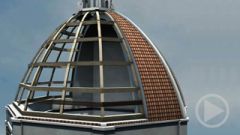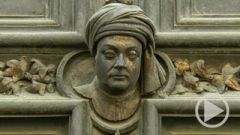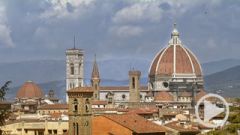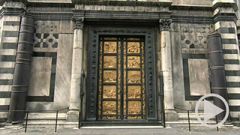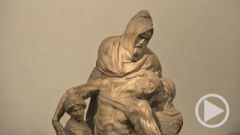- Home
- »
- Welcome
- »
- Italy
- »
- Florence
- »
- Florence Cathedral
- »
- Florence Cathedral - The Gates of Paradise
The Gates Of Paradise
The Gates of Paradise
Filippo doesn’t live to see his rival’s greatest triumph. He has already been dead for six years when Lorenzo Ghiberti completes the last portal for the baptistery. For 25 years he has worked on the project, and created an immortal masterpiece.
This time, Lorenzo subdivided the doors into ten larger sections. He relates several stories within each section, embedded in complex settings. The first panel up on the left shows the creation of Adam – then the creation of Eve. Lorenzo lends an astonishing depth to what are almost flat images: the scene depicting the Fall of Man, for example, he places in the background. Here not only are the figures smaller, the relief is also flatter – thereby suggesting a rather hazy distance.

The expulsion of Adam and Eve from Paradise forms the transition to the next section, which shows how humans are now obliged to earn their own living by physical toil. The image of Noah’s benediction contains astonishingly realistic renditions of a lion and an elephant – a sensational sight for the people of Florence in the year 1452. The central panels, placed at eye level, have particularly interesting backgrounds. Lorenzo transposes the story of Jacob and Esau, who sells his birthright for a plate of lentils, to a monumental city – and applies with the utmost perfection the rules of perspective, developed by Filippo 40 years earlier.
Apart from their artistic mastery, the reliefs also contain many political references. For example, the figure of small, but victorious David is often used as a symbol of the city of Florence – the famous sculpture by Michelangelo springs to mind. The last scene shows Solomon, meeting the Queen of Sheba. This is an allusion to the Council of Florence, where the Catholic and orthodox churches had reconciled their differences in 1439 – a major coup for the Florentines. The success was however short-lived, as the schism persists to this day. Lorenzo has again included a self-portrait. He’s now over 70 years old. The ‘Gates of Paradise’ as they are known, are his most famous and his last work. Three years later, on December 1st 1455, Lorenzo Ghiberti also dies.

The portal is world famous to this day. Michelangelo himself is said to have cried out at the sight of the doors that they were indeed worthy of their lofty label. But in reality the name “Gates of Paradise” probably stems from the fact that the space between the cathedral and the baptistery has always been referred to as “paradise”. This is where Lorenzo’s door finds its place. Andrea Pisano’s portal is relocated to the south side. And that is a sensation!
Up to now, the main portal showed the life of John the Baptist. That befits the baptistery. With their baptism, people demonstrate their commitment to the gospel of the new testament. But Lorenzo’s portal relates stories from the Old Testament. Actually intended for the side entrance, it now usurps the old doors – and for one single reason: because it is more beautiful.
That would have been unthinkable in the Middle Ages. But now, the beauty of the work of art and admiration for the artist are more important than the Biblical content. A new worldview has taken hold. The Renaissance is born. So Lorenzo Ghiberti also found his fame and glory. To this day he’s revered as a brilliant sculptor.
But Filippo has also made a lasting contribution to art: his new perspective technique soon becomes the standard throughout Europe. In the cathedral itself, it’s not only Lorenzo who employs the technique: the sacristy is lined with magnificent intarsia work. Illusionistic pictures such as these were not possible before Filippo.


